We don’t know if Max and Dave Fleischer gambled in the stock market, as so many in show business had done. If they didn’t, that was a good thing for them, as they didn’t have to go bare-chested after having lost their shirts. But the deal with Paramount remained a good thing for them, providing a regular outlet for their releases. Paramount further followed through with the promotional budgets, putting ads in all the trade papers, etc. Nobody knew at this juncture how deep the depression would get – or that they were even in a depression – but they knew the market had dropped from its previous peak in September of 1929. In keeping spirits up, the Screen Songs continued, and the ball kept bouncing.
 Oh, You Beautiful Doll (10/24/29) – A cat is trying to tidy up a music store, with no help from a nervy mouse. A female customer comes in, and the cat sees opportunity for “Business – Monkey Business”. He gets flirtatious with her to the title tune, while the mouse is throwing things at his noggin. Billy Murray recites the alter call, encourging the audience to sing along, but does not join in the singing. The first chorus is presented entirely instrumentally, then there are the usual second chorus gags, as well as an ending gag involving a large Swiss cheese, which does not last long as a horde of mice go after it. The title song is from 1912, recorded by Billy Murray and the American Quartet on Victor and Edison. In the 1940’s the tune was adapted by Chuck Foster’s Orchestra as his theme song, likely appearing only on airchecks and transcriptions. In 1958, the tune was rocked up by “Ivan” (really Jerry Ivan Allison), a back-up guitarist from Buddy Holly’s group (with Buddy also playing guitar on the record).
Oh, You Beautiful Doll (10/24/29) – A cat is trying to tidy up a music store, with no help from a nervy mouse. A female customer comes in, and the cat sees opportunity for “Business – Monkey Business”. He gets flirtatious with her to the title tune, while the mouse is throwing things at his noggin. Billy Murray recites the alter call, encourging the audience to sing along, but does not join in the singing. The first chorus is presented entirely instrumentally, then there are the usual second chorus gags, as well as an ending gag involving a large Swiss cheese, which does not last long as a horde of mice go after it. The title song is from 1912, recorded by Billy Murray and the American Quartet on Victor and Edison. In the 1940’s the tune was adapted by Chuck Foster’s Orchestra as his theme song, likely appearing only on airchecks and transcriptions. In 1958, the tune was rocked up by “Ivan” (really Jerry Ivan Allison), a back-up guitarist from Buddy Holly’s group (with Buddy also playing guitar on the record).
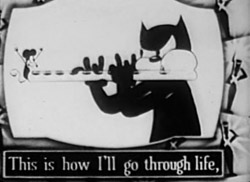 Several additional songs appear in the score of the cartoon, including “By the Beautiful Sea” (a 1914 song, revived in 1948 by Spike Jones for Victor), “The Cat” (a song penned by Isham Jones, recorded by him for Brunswick, and by the California Ramblers on Edison), “The Whisper Song (When the Pussy Willows Whispers to the Catnip)”, recorded by Art Landry on Victor, and a vocal version by the California Humming Birds on Victor), and “I Miss My Swiss”, most notably performed by the Happiness Boys on Victor and Columbia, with dance versions by Paul Whiteman on Victor, Carl Fenton on Brunswick, Ted Lewis on Columbia, the California Ramblers on the dime-store labels, and the Southern Serenaders (a Sam Lanin group including several Fletcher Henderson musicians including Louis Armstrong) on Harmony.
Several additional songs appear in the score of the cartoon, including “By the Beautiful Sea” (a 1914 song, revived in 1948 by Spike Jones for Victor), “The Cat” (a song penned by Isham Jones, recorded by him for Brunswick, and by the California Ramblers on Edison), “The Whisper Song (When the Pussy Willows Whispers to the Catnip)”, recorded by Art Landry on Victor, and a vocal version by the California Humming Birds on Victor), and “I Miss My Swiss”, most notably performed by the Happiness Boys on Victor and Columbia, with dance versions by Paul Whiteman on Victor, Carl Fenton on Brunswick, Ted Lewis on Columbia, the California Ramblers on the dime-store labels, and the Southern Serenaders (a Sam Lanin group including several Fletcher Henderson musicians including Louis Armstrong) on Harmony.
 After the Ball (11/8/29) – No real plot. Gags about the writinng of the song, with a dog that looks a great deal like Fitz. “Auld Lang Syne” also makes an appearance in the score, as the film centers somewhat around nostalgia. The title tune goes back to 1892. A recording exists from shortly therefter by George J. Gaskin (boy tenor) – company is unknown as an announcement does not appear on accessible copies of the recording. In 1925 it was recorded electrically by the International Novelty Orchestra, with vocal by Henry Burr, for Victor. Ian Whitcomb would revive it on LP among other nostalgic fare in the 1970’s. The song is often thought of as Tin Pan Alley’s first hit – the first tune to sell over a million copies on sheet music. Here’s the composer himself, Charles K. Harris, singing the song in 1930:
After the Ball (11/8/29) – No real plot. Gags about the writinng of the song, with a dog that looks a great deal like Fitz. “Auld Lang Syne” also makes an appearance in the score, as the film centers somewhat around nostalgia. The title tune goes back to 1892. A recording exists from shortly therefter by George J. Gaskin (boy tenor) – company is unknown as an announcement does not appear on accessible copies of the recording. In 1925 it was recorded electrically by the International Novelty Orchestra, with vocal by Henry Burr, for Victor. Ian Whitcomb would revive it on LP among other nostalgic fare in the 1970’s. The song is often thought of as Tin Pan Alley’s first hit – the first tune to sell over a million copies on sheet music. Here’s the composer himself, Charles K. Harris, singing the song in 1930:
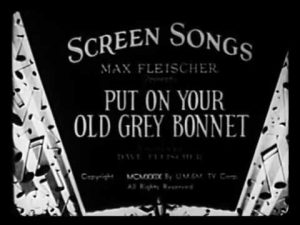 Put On Your Old Grey Bonnet (11/22/29) – A village orchestra gets ready to rehearse, including a flautist who cuts off a piece of his flute and converts it to a piccolo, and a saxophonist having trouble with one of the holes on his instrument, which doesn’t want to stay in place. He somehow winds up playing a “Jew’s” harp. Recorded versions included the Haydn Quartet on Victor, Arthur Cliugh on Columbia (a high counter-tenor), Helen Clark and Joseph A. Phillips on Edison Diamond Disc, Glen Gray and the Casa Loma Orchestra on both Okeh and Brunswick, the Mills Brothers on Brunswick, the Dixie Ramblers on Bluebird (a Cajun string band performing for non-Cajun audiences), Milton Brown and his Brownies on Decca, Jimmie Lunceford on Decca, Ozzie Nelson (below) on Vocalion, the Sweet Violet Boys (aka the Prairie Ramblers) on Vocalion (with some parody lyrics about wearing a red bonnet in the vicinity of a bull), and much later, the Mulcays (harmonica duo) on MGM.
Put On Your Old Grey Bonnet (11/22/29) – A village orchestra gets ready to rehearse, including a flautist who cuts off a piece of his flute and converts it to a piccolo, and a saxophonist having trouble with one of the holes on his instrument, which doesn’t want to stay in place. He somehow winds up playing a “Jew’s” harp. Recorded versions included the Haydn Quartet on Victor, Arthur Cliugh on Columbia (a high counter-tenor), Helen Clark and Joseph A. Phillips on Edison Diamond Disc, Glen Gray and the Casa Loma Orchestra on both Okeh and Brunswick, the Mills Brothers on Brunswick, the Dixie Ramblers on Bluebird (a Cajun string band performing for non-Cajun audiences), Milton Brown and his Brownies on Decca, Jimmie Lunceford on Decca, Ozzie Nelson (below) on Vocalion, the Sweet Violet Boys (aka the Prairie Ramblers) on Vocalion (with some parody lyrics about wearing a red bonnet in the vicinity of a bull), and much later, the Mulcays (harmonica duo) on MGM.
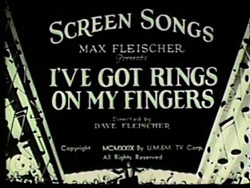 I’ve Got Rings on My Fingers (12/28/29) – A traffic cop tries to direct traffic among passing airplanes and flocks of birds. He winds up getting stranded on a remote island. The score is loaded with snatches of incidental numbers, including “Bye Bye Blackbird” (recorded by George Olsen on Victor, Bennie Krueger on Brunswick, and Leo Reisman on Columbia, and vocal versions by Nick Lucas on Brunswick and Gene Austin on Victor), as a flock of such species is directed by the cop; “Come Take a Trip In My Airship” appears again; “He Walked Right In, Turned Around, and Walked Right Out Again” (recorded by Eddie Morton on Victor); “Mean To Me” (by Leo Reisman on Victor, Ted Wallace and his Campus Boys on Columbia, Ben Bernie on Brunswick, and vocals by Ruth Etting on Columbia, and Chester Gaylord on Brunswick; “I’m Wild About Horns on Automobiles” (recorded by Eddie Cantor on Victor, Billy Murray on Edison, and a dance version by Billy Hays on Victor); “Let It Rain, Let It Pour (I’ll Be in Virginia In the Morning)” (recorded by Meyer Davis’ Le Paradis Band on one of the earliest Victor electricals with Billy Murray on vocal refrain, The Columbians on Columbia in another very early electrical, and as a vocal by Charlie Wellman on Brunswick).
I’ve Got Rings on My Fingers (12/28/29) – A traffic cop tries to direct traffic among passing airplanes and flocks of birds. He winds up getting stranded on a remote island. The score is loaded with snatches of incidental numbers, including “Bye Bye Blackbird” (recorded by George Olsen on Victor, Bennie Krueger on Brunswick, and Leo Reisman on Columbia, and vocal versions by Nick Lucas on Brunswick and Gene Austin on Victor), as a flock of such species is directed by the cop; “Come Take a Trip In My Airship” appears again; “He Walked Right In, Turned Around, and Walked Right Out Again” (recorded by Eddie Morton on Victor); “Mean To Me” (by Leo Reisman on Victor, Ted Wallace and his Campus Boys on Columbia, Ben Bernie on Brunswick, and vocals by Ruth Etting on Columbia, and Chester Gaylord on Brunswick; “I’m Wild About Horns on Automobiles” (recorded by Eddie Cantor on Victor, Billy Murray on Edison, and a dance version by Billy Hays on Victor); “Let It Rain, Let It Pour (I’ll Be in Virginia In the Morning)” (recorded by Meyer Davis’ Le Paradis Band on one of the earliest Victor electricals with Billy Murray on vocal refrain, The Columbians on Columbia in another very early electrical, and as a vocal by Charlie Wellman on Brunswick).
 Also “My Bonnie Lies Over the Ocean”; “I’ve Got a Feeling I’m Falling” (recorded in a brilliant recording by Nat Shilkret and the Victor Orchestra with Jesse Crawford on Victor, Ted Wallace and his Campus Boys on Brunswick, Ben Bernie on Brunswick, and a vocal version on Victor by Gene Austin); “I Fall Down and Go Boom” (covered by George Olsen on Victor, Charles Fulcher on Columbia, and vocals by Vaughn DeLeath on Okeh, Eddie Cantor on Victor, and Annette Hanshaw (anonymously as “Dot Dare”), doing a Helen Kane impression on Harmony), “Gary Owen”; “A Hot Time In the Old Town Tonight”; “Yes, We Have No Bananas” (a 1923 song by the Great White Way Orchestra on Victor, the Original Memphis Five on Columbia, and revived by Spike Jones in the 1940’s for Victor);, and “Whar’s the Matter With Father”. Finally, the title song was introduced by Blanche Ring in a Broadway show, and recorded by her on Victor, first as a black seal, then reissued in the higher-priced purple seal label. Ada Jones got it for Columbia and on Albany Indestructible Cylinders. Harry Fay recorded it in England for Zonophone. There was a revival in the early 40’s by Dick Kuhn on blue Decca.
Also “My Bonnie Lies Over the Ocean”; “I’ve Got a Feeling I’m Falling” (recorded in a brilliant recording by Nat Shilkret and the Victor Orchestra with Jesse Crawford on Victor, Ted Wallace and his Campus Boys on Brunswick, Ben Bernie on Brunswick, and a vocal version on Victor by Gene Austin); “I Fall Down and Go Boom” (covered by George Olsen on Victor, Charles Fulcher on Columbia, and vocals by Vaughn DeLeath on Okeh, Eddie Cantor on Victor, and Annette Hanshaw (anonymously as “Dot Dare”), doing a Helen Kane impression on Harmony), “Gary Owen”; “A Hot Time In the Old Town Tonight”; “Yes, We Have No Bananas” (a 1923 song by the Great White Way Orchestra on Victor, the Original Memphis Five on Columbia, and revived by Spike Jones in the 1940’s for Victor);, and “Whar’s the Matter With Father”. Finally, the title song was introduced by Blanche Ring in a Broadway show, and recorded by her on Victor, first as a black seal, then reissued in the higher-priced purple seal label. Ada Jones got it for Columbia and on Albany Indestructible Cylinders. Harry Fay recorded it in England for Zonophone. There was a revival in the early 40’s by Dick Kuhn on blue Decca.
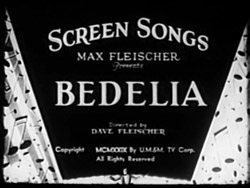 Bedelia (1/3/30) – A character goes in his car to visit his girlfriend, but finds her asleep. The date doesn’t go as planned, and he winds up with a flower pot on his head. Underscore inclides “Do I Know What I’m Doing?” (recorded by Ethel Waters for Columbia); “Please Let Me Sleep” (an oldie from 1902, used quite frequently in cartoons, such as in the stork sequence from Mickey Mouse’s “Clock Cleaners” – no recording seems to turn up except a modern-day web performance by “Sheet Music Singer”); “Oh, How I Hate To Get Up In the Morning”; “Comin’ Thru the Rye”; “Old Black Joe”; and “What Wouldn’t I Do For That Man” (performed by the Charleston Chasers with Benny Goodman on Columbia, and as a vocal record by Helen Morgan on Victor – a torch singer familiar in parody to anyone who’s seen the ending of Warner’s “The Coo Coo Nut Grove”). “Bedelia” was from 1903, recorded by Billy Murray for Edison cylinder, the Haydn Quartet for Victor, and Arthur Collins for Monarch. Sousa’s Band would record a sort of “theme and variation” spoof in multiple tempos as “A Musical Joke on Bedelia” for Victor. Jan Garber recorded it on Okeh in the early 1940’s. James Moody later dredged it up for Blue Note as a sax instrumental. The song’s lyric also makes a reference to singer/composer Chauncy Olcott, who recorded a number of Irish standards during 1913-1920, and was the composer of “My Wild Irish Rose.”
Bedelia (1/3/30) – A character goes in his car to visit his girlfriend, but finds her asleep. The date doesn’t go as planned, and he winds up with a flower pot on his head. Underscore inclides “Do I Know What I’m Doing?” (recorded by Ethel Waters for Columbia); “Please Let Me Sleep” (an oldie from 1902, used quite frequently in cartoons, such as in the stork sequence from Mickey Mouse’s “Clock Cleaners” – no recording seems to turn up except a modern-day web performance by “Sheet Music Singer”); “Oh, How I Hate To Get Up In the Morning”; “Comin’ Thru the Rye”; “Old Black Joe”; and “What Wouldn’t I Do For That Man” (performed by the Charleston Chasers with Benny Goodman on Columbia, and as a vocal record by Helen Morgan on Victor – a torch singer familiar in parody to anyone who’s seen the ending of Warner’s “The Coo Coo Nut Grove”). “Bedelia” was from 1903, recorded by Billy Murray for Edison cylinder, the Haydn Quartet for Victor, and Arthur Collins for Monarch. Sousa’s Band would record a sort of “theme and variation” spoof in multiple tempos as “A Musical Joke on Bedelia” for Victor. Jan Garber recorded it on Okeh in the early 1940’s. James Moody later dredged it up for Blue Note as a sax instrumental. The song’s lyric also makes a reference to singer/composer Chauncy Olcott, who recorded a number of Irish standards during 1913-1920, and was the composer of “My Wild Irish Rose.”
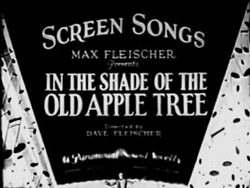 In the Shade of the Old Apple Tree (1/16/30) – Gentle gags with a couple spooning under the shade of the arboreal title genus. The title song dates from 1902. Harry Macdonoigh and the Haydyn Quartet recorded it for Victor, while Billy Murray got to perform “A Parody On” for the same label. Henry Burr would also issue a Victor version a few years later. The Old Smokey Twins would give out a country version in the 1920’s on Paramount. Duke Ellington modernized it on Brunswick in the 30’s. Louis Armstrong (below) and the Mills Brothers swung it in the 1930’s for Decca Claude Hopkins also recorded it for Decca. Benny Goodman had a band book arrangement recorded live on an aircheck, sounding like a Fletcher Henderson chart. Maurice Rocco and his Rockin’ Rhythm would giive it a 40’s feel for Musicraft.
In the Shade of the Old Apple Tree (1/16/30) – Gentle gags with a couple spooning under the shade of the arboreal title genus. The title song dates from 1902. Harry Macdonoigh and the Haydyn Quartet recorded it for Victor, while Billy Murray got to perform “A Parody On” for the same label. Henry Burr would also issue a Victor version a few years later. The Old Smokey Twins would give out a country version in the 1920’s on Paramount. Duke Ellington modernized it on Brunswick in the 30’s. Louis Armstrong (below) and the Mills Brothers swung it in the 1930’s for Decca Claude Hopkins also recorded it for Decca. Benny Goodman had a band book arrangement recorded live on an aircheck, sounding like a Fletcher Henderson chart. Maurice Rocco and his Rockin’ Rhythm would giive it a 40’s feel for Musicraft.
 I’m Afraid To Come Home In the Dark (2/1/30) – A proto-Binbo sneaks out of a bar in the wee small hours and engages in a fight with his own shadow. The title song was issued by Billy Murray for Victor and Columbia. Victor would issue a second version by Clarice Vance. Collins and Harlan would record a cylinder version (label unknown). Bob Roberts cut it for Indestructible Cylinder, Military Band versions included Prince’s Band on Columbia, and the New York Military Band on Edison.
I’m Afraid To Come Home In the Dark (2/1/30) – A proto-Binbo sneaks out of a bar in the wee small hours and engages in a fight with his own shadow. The title song was issued by Billy Murray for Victor and Columbia. Victor would issue a second version by Clarice Vance. Collins and Harlan would record a cylinder version (label unknown). Bob Roberts cut it for Indestructible Cylinder, Military Band versions included Prince’s Band on Columbia, and the New York Military Band on Edison.
 The Prisoner’s Song (3/1/30) – Spot gags on prison life, concentrating on the old rock pile. No songs appear other than the title tune, except for a musical counter-melody appearing at the opening of the film, which sort of sounds like the Anvil Chorus played sideways. The title song was recorded for everybody and his brother by Vernon Dalhart, recorded for Victor, Brunswick, Edison, Okeh (as “Tobe Little”), and a host of other minor labels. It was also recorded as a waltz by the International Novelty Orchestra on Victor, and by Ross Gorman and his Earl Carroll Vanities Orchestra on Columbia (still with Vernon Dalhart singing!). The song became a standard in country music, and would be revived over the years by various singers, including Hank Snow (RCA), and was even referred to in one song, “For No Good Reason at All”, by Cliff Edwards of Perfect/Pathe. There was also a concert version recorded by Reinald Werrenwrath for red seal Victor. Bunny Berigan also recorded a 12″ extended-length swing version for Victor (part of the “Five Feet of Swing” set, coupled as the flip side of Berigan’s biggeast hit, “I Can’t Get Started”).
The Prisoner’s Song (3/1/30) – Spot gags on prison life, concentrating on the old rock pile. No songs appear other than the title tune, except for a musical counter-melody appearing at the opening of the film, which sort of sounds like the Anvil Chorus played sideways. The title song was recorded for everybody and his brother by Vernon Dalhart, recorded for Victor, Brunswick, Edison, Okeh (as “Tobe Little”), and a host of other minor labels. It was also recorded as a waltz by the International Novelty Orchestra on Victor, and by Ross Gorman and his Earl Carroll Vanities Orchestra on Columbia (still with Vernon Dalhart singing!). The song became a standard in country music, and would be revived over the years by various singers, including Hank Snow (RCA), and was even referred to in one song, “For No Good Reason at All”, by Cliff Edwards of Perfect/Pathe. There was also a concert version recorded by Reinald Werrenwrath for red seal Victor. Bunny Berigan also recorded a 12″ extended-length swing version for Victor (part of the “Five Feet of Swing” set, coupled as the flip side of Berigan’s biggeast hit, “I Can’t Get Started”).
Next Time: More Screen Songs from 1930. Then, we will approach the Talkartoons.


 James Parten has overcome a congenital visual disability to be acknowledged as an expert on the early history of recorded sound. He has a Broadcasting Certificate (Radio Option) from Los Angeles Valley College, class of 1999. He has also been a fan of animated cartoons since childhood.
James Parten has overcome a congenital visual disability to be acknowledged as an expert on the early history of recorded sound. He has a Broadcasting Certificate (Radio Option) from Los Angeles Valley College, class of 1999. He has also been a fan of animated cartoons since childhood.










































I really hate to correct your correct spelling, but the title of the song that plays briefly in “I’ve Got Rings on My Fingers” when the cop falls out of the sky and lands on the tropical island is actually “I Faw [sic] Down an’ [sic] Go Boom”. My mother had the sheet music and used to play it on the piano when I was little. “I’ve Got Rings on My Fingers” and “Bedelia” are very early examples of cartoons using snatches of popular songs to punctuate gags, a technique that would reach its zenith with Stalling at Warner Bros.
Vernon Dalhart’s 1924 recording of “The Prisoner’s Song” is sometimes cited as the first country music hit record, but that title properly belongs to Wendell Hall’s “It Ain’t Gonna Rain No Mo'”, released the previous year.
“After the Ball” is notable for featuring an animated likeness of the song’s composer as a central character. I don’t think there are many cartoons that do that. In Van Beuren’s “Fresh Ham” (1933), an animated Irving Berlin pops out of a photograph frame and moans “Oy oy OY oy oy!” in frustration when Cubby Bear keeps hitting a wrong note on the piano while playing “Alexander’s Ragtime Band”. And George Gershwin has a cameo in the “Rhapsody in Blue” segment of Fantasia 2000. And then there’s the Beatles. And all the cameos on The Simpsons by Paul Anka and James Taylor and Marvin Hamlisch and Stephen Sondheim and…. Oh, just forget I ever brought it up.
Eddie Cantor sings “I Faw Down And Go Boom”.
With Nat Shilkret’s Orchestra.
Recorded in New York City,
1/28/29, for Victor Records.
https://www.youtube.com/watch?v=08JqYLv53Pk
Ian Whitcomb also wrote a very entertaining book entitled “After the Ball,” a pocket history of American popular music. He’s best remembered for his pop hit “You Turn Me On,” and a chapter in the book was devoted to Whitcomb’s brief fame as a rock star.
It was the first book that I ever read dedicated to pop music history.
Same here. That, and “The Story of Rock” by Carl Belz.
The guy from the Donna Reed Show?
Click below to see BEDELIA:
https://youtu.be/hDkM1S9kaoo
I believe the Fleischers were the last animators who hadn’t switched to cels at this point in history.
Here is PUT ON YOUR OLD GREY BONNET
https://www.youtube.com/watch?v=dDtdJUrtVNY
So is there any source material for these cartoons better than the smudgy 10th generation copies out there? Who has them?
I’d like to point out that the actual Edison rendition of “The Cat” was actually made by Phil Napoleon’s Orchestra, and not the California Ramblers, who recorded it for Okeh as Ted Wallace & his Orchestra.
I recently discovered this amusing version of “In The Shade Of The Old Apple Tree”, arranged and conducted by Pete Rugolo (one of Stan Kenton’s longtime arrangers).
Recorded in High-Fidelity for Mercury Records, 1956.
https://www.youtube.com/watch?v=U6AU5uJBKaI
I’m 100% sure that the Harris clip you attributed to 1930 is actually from the “After the Ball” short itself (1929), and the comments in the YouTube video you embedded state such. All circulating prints of “After the Ball” online run around 5 minutes (much shorter than other prints of Screen Songs from around the same era) and contain a rather abrupt cut. Specifically, the shot where the dog blows out the candle cuts to a shot where the dog plays on the piano. Note that the other prints of Screen Songs available feature multiple verses – the existing print of “After the Ball” only features the chorus.
So here’s my theory: after the dog blows out the candle, it dissolved to the live-action footage of Charles K. Harris. If anyone has any insights or corrections to make, please let me know.
Good catch! I never noticed it before, but you’re right: there’s a visible splice in the N.T.A. version where the blackness with the dog saying “Shhhhhh!” cuts to the dog playing on the piano. And the embedded clip with Harris contains another brief shot of the dog at the piano that confirms it.
Just for fun, I put them back together. Fit right in! Unfortunately, Charles K. Harris’s self introduction is partially missing. You can see it at: https://rumble.com/vjf8l7-after-the-ball-1929-fleischer-screen-song-complete.html
Man, I wish good versions of these were available!